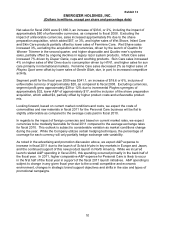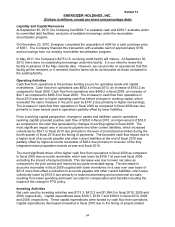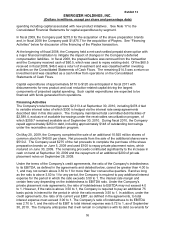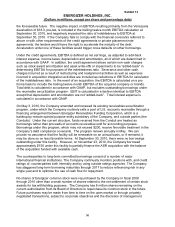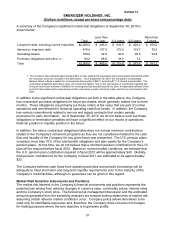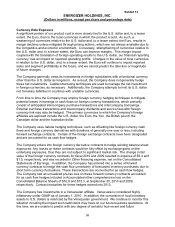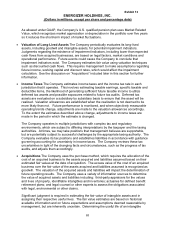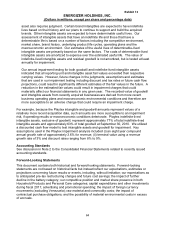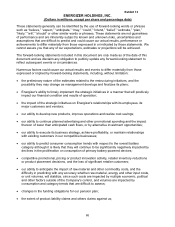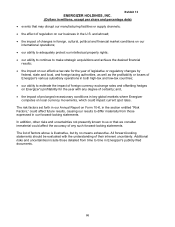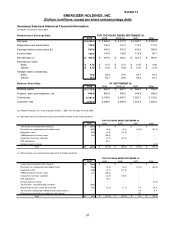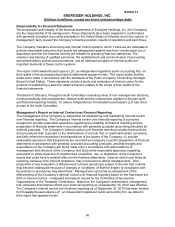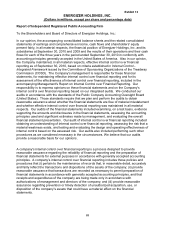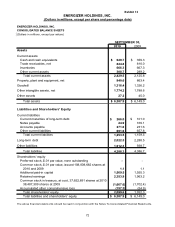Energizer 2010 Annual Report Download - page 72
Download and view the complete annual report
Please find page 72 of the 2010 Energizer annual report below. You can navigate through the pages in the report by either clicking on the pages listed below, or by using the keyword search tool below to find specific information within the annual report.
Exhibit 13
ENERGIZER HOLDINGS, INC.
(Dollars in millions, except per share and percentage data)
62
season progresses. We monitor shipment activity and inventory levels at key retailers
during the season in an effort to gauge potential returns issues. This allows the Company to
manage shipment activity to our customers, especially in the latter stages of the sun care
season, to reduce the potential for returned product. The level of returns may fluctuate from
our estimates due to several factors including weather conditions, customer inventory
levels, and competitive activity. Based on our fiscal 2010 sun care shipments, each
percentage point change in our returns rate would have impacted our reported net sales by
approximately $2.8 and our reported operating income by approximately $2.6.
The Company offers a variety of programs, primarily to its retail customers, designed to
promote sales of its products. Such programs require periodic payments and allowances
based on estimated results of specific programs and are recorded as a reduction to net
sales. The Company accrues, at the time of sale, the estimated total payments and
allowances associated with each transaction. Additionally, the Company offers programs
directly to consumers to promote the sale of its products. Promotions which reduce the
ultimate consumer sale prices are recorded as a reduction of net sales at the time the
promotional offer is made, generally using estimated redemption and participation levels.
Taxes we collect on behalf of governmental authorities, which are generally included in the
price to the customer, are also recorded as a reduction of net sales.
The Company continually assesses the adequacy of accruals for customer and consumer
promotional program costs not yet paid. To the extent total program payments differ from
estimates, adjustments may be necessary. Historically, these adjustments have not been
material to annual results.
• Pension Plans and Other Postretirement Benefits The determination of the Company’s
obligation and expense for pension and other postretirement benefits is dependent on
certain assumptions developed by the Company and used by actuaries in calculating such
amounts. Assumptions include, among others, the discount rate, future salary increases
and the expected long-term rate of return on plan assets. Actual results that differ from
assumptions made are recognized on the balance sheet and subsequently amortized to
earnings over future periods. Significant differences in actual experience or significant
changes in macroeconomic conditions resulting in changes to assumptions may materially
affect pension and other postretirement obligations. In determining the discount rate, the
Company generally uses the yield on high-quality bonds that coincide with the cash flows of
its plans’ estimated payouts. For the U.S. plans, which represent the Company’s most
significant obligations, we consider both the CitiGroup and Mercer yield curves in
determining the discount rates.
Of the assumptions listed above, changes in the expected long-term rate of return on plan
assets and changes in the discount rate used in developing plan obligations will likely have
the most significant impact on the Company’s annual earnings prospectively. Based on
plan assets at September 30, 2010, a one percentage point decrease or increase in actual
asset returns would decrease or increase the Company’s pre-tax pension expense by
approximately $8. In addition, it may increase and accelerate the rate of required pension
contributions in the future. Uncertainty related to economic markets and the availability of
credit may produce changes in the yields on corporate bonds rated as high-quality. As a
result, discount rates based on high-quality corporate bonds may increase or decrease
leading to lower or higher, respectively, pension obligations. A one percentage point
decrease in the discount rate would increase obligations by approximately $91 at
September 30, 2010.


